

WORLD
China Celebrates a Major Victory: What’s the Hidden Agenda Behind Their Success?
Published
1 month agoon
By
OBS
Suranjana TewariAsia Business Correspondent and
Osmond ChiaBusiness reporter

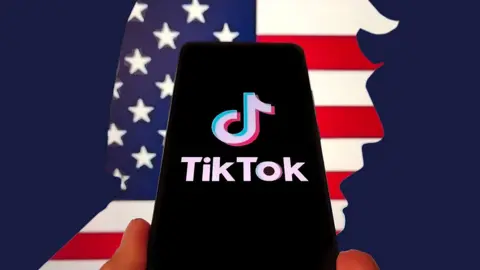 Getty Images
Getty ImagesA much-awaited deal over TikTok may be close, with US President Donald Trump and his Chinese counterpart Xi Jinping set to discuss terms on Friday.
Top officials from both sides struck a “framework” agreement this week, which reports suggest could see TikTok’s US operations sold to a group of American firms.
If the deal goes through, it would be what one expert called a “rare breakthrough” in US-China trade negotiations – and one which settles an issue that has made headlines for years.
Experts have been telling the BBC what a final deal might look like for TikTok’s 170 million US users, and what Beijing might get in return.
The US may not get the ‘secret sauce’
Chinese state media is calling it a “win-win” for both countries, while Trump has said “I’d like to do it for the kids”.
But a lot about “it” still remains unclear.
Reports suggest that American users would be offered a new US-specific version of the app. And that the US operations could be bought by a consortium that includes technology giant Oracle, and investment firms Andreessen Horowitz and Silver Lake. The BBC has contacted the companies for comment.
But what exactly is on the table? At the heart of the tussle is TikTok’s algorithm – the “secret sauce” that recommends content to users based on their preferences and behaviours.
It’s key because it drives the app’s virality and appeal. Other companies have tried to re-create the algorithm – Instagram has Reels, YouTube has Shorts – but they are not as good, a former social media executive who worked for Snap and Viber told the BBC, speaking on the condition of anonymity.
“Generally, the one who introduces the technology just knows how to do it better.”

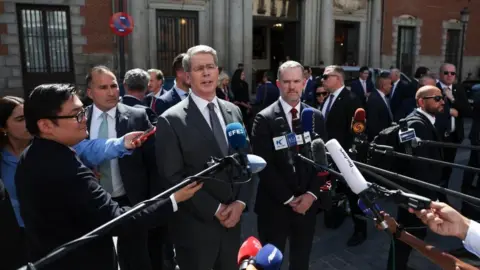 Reuters
ReutersTikTok’s Chinese owner, Bytedance, understandably refused to part with the prized formula, and Beijing backed the firm.
But in a twist few saw coming, China’s top cybersecurity regulator has signalled that Beijing may allow ByteDance to license the algorithm and other intellectual property (IP) to a US company owner. But it will not be transferred outright.
It’s a major departure from China’s previous hardline stance over the algorithm.
But there’s every chance the US version will run on a “stripped-down” version of the app’s software, said computing expert Kokil Jaidka from the National University of Singapore.
Even limited access could reveal how the technology drives engagement, moderation and ad targeting – all the things that make the app so profitable, she adds.
“It simply doesn’t make business sense for ByteDance to hand over its most valuable asset when a lighter version can keep the app running without giving away its edge.”
But these changes will affect the user experience – the app may show less diverse content than users might see elsewhere, Dr Jaidka adds.
“A lighter, slower, more domestic version – while ByteDance keeps the crown jewels in Beijing.”
The deal could still be a while away
The user experience will remain the same, and with “Chinese characteristics”, according to US Treasury Secretary Scott Bessent, who is leading his side’s negotiating team.
The “Chinese characteristics” may well be the problem though – that is, in fact, a phrase often used by the Chinese Communist Party to differentiate its way of doing things.
US officials, including Trump during his first term, have long raised concerns about who has access to TikTok’s data, and the influence the app has over US users.
These questions over national security spurred legislation that former president Joe Biden signed into law last year, requiring TikTok to hand over control of its US operations or face a ban.
Trump has since changed his mind, crediting TikTok for boosting young voter support in his 2024 election win.
But a sale must still satisfy US lawmakers and allay the worries that kickstarted everything. Congress is likely to need to approve any agreement, and there is already political backlash in Washington on both sides of the aisle.
Republican lawmaker John Moolenaar has said he is concerned that the agreed framework could still allow Chinese government influence and control.
“Put simply: the statute requires full separation from ‘foreign adversary’ control, and a license would not appear to meet that test,” lawyer Hdeel Abdelhady told the BBC.

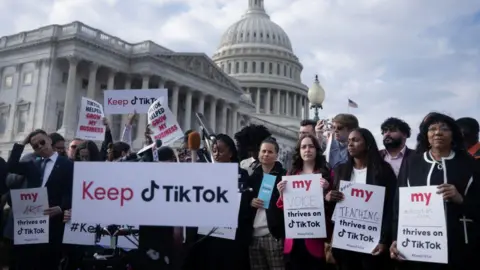 Getty Images
Getty ImagesDeals of this size typically take months or even years to complete, and there are a number of issues to resolve.
For one, it is not clear how US-owned and operated TikTok would interact with TikTok elsewhere, which would be still be owned by ByteDance.
And two, ByteDance, being a private company, would need approval from its board for the arrangement to proceed.
That adds a layer of complication even if the Chinese government – which enforces export controls on advanced technologies like algorithms – has already approved the deal.
And the US president himself, who has proven to be an unpredictable trade partner, could create fresh complications.
Beijing buys time – and leverage
We know Trump is keen on a TikTok deal, and we know why.
It would be a big win for his administration. One in seven people in the world use the app, which also doubles up as a huge marketplace for buyers and sellers across the world, from the US to Germany, Indonesia to the Philippines.
“This is the only social media app that didn’t originate in the US and so it’s very valuable,” the former social media executive said.
The average revenue per user for most social media apps in the US is five to 10 times higher than other countries, with America likely making up something close to 50% of ByteDance’s overall revenue, he added.
Tech news site The Information estimated ByteDance’s global revenue to be $39bn (£28.6bn) in 2024, with TikTok accounting for $30bn.
What we don’t know yet is how China would gain from such a deal.
The licensing deal will allow ByteDance to keep its algorithm under wraps – a strategic advantage if the US ever intends to launch new apps to compete with those already operating in the country, said computer scientist Ben Leong.
And rather than be banned, TikTok gets to stay in the US market. TikTok’s parent would also retain the single biggest stake in the app, along with the logo, format and branding.

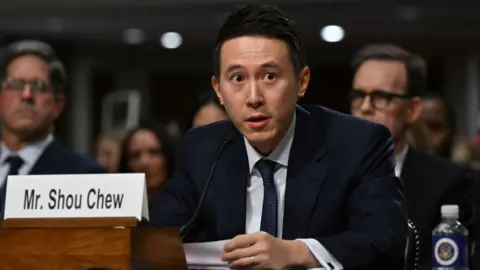 Getty Images
Getty ImagesThe deal also creates a “TikTok Template” for other Chinese companies to deploy their technology in the US through licensing, investor and tech expert Kevin Xu wrote in his recent newsletter.
He added that ready-to-go Chinese technologies that matter to national competitiveness, like batteries and rare earths, could now flow to the US more easily.
“This is the formula that will likely be applied should, say, BYD want to make a jump into the US market, or CATL want to step up its expansion to supply more US carmakers with its batteries.”
China can spin the deal as a win – it is exporting Chinese-made tech on its own terms. And that might be critical leverage for Beijing in trade negotiations with Washington.
“The Chinese side have called the talks in depth, constructive and candid. That signals that they are actually quite happy with how things are going,” said former World Bank Country Director for China Bert Hofman. “Question is when will there be a full deal?”
A TikTok deal could buy them time for exactly that. The US is a huge export market for China, and China is a major buyer of American agricultural goods. High tariffs would hurt both. There are also export controls on both sides, especially restricting US access to rare earths, which China has a near monopoly over.
Ultimately, it seems a breakthrough on TikTok is progress for China. The US may get a deal, but perhaps not the coup Trump had in mind.
“The deal might work on paper – but in practice, it will always sit under a cloud,” Dr Jaidka said.
“A US TikTok will look like the same app, but behind the scenes it will run on borrowed code, firewalled data, and political trust that could vanish overnight.”
You may like
WORLD
Unlocking Opportunities: How Trump’s $100,000 Visa Could Revolutionize Indian and US Industries!
Published
1 month agoon
September 22, 2025By
OBS
Soutik Biswas and Nikhil InamdarDelhi
Panic, confusion and then a hasty White House climbdown – it was a weekend of whiplash for hundreds of thousands of Indians on H-1B visas.
On Friday, US President Donald Trump stunned the tech world by announcing an up to 50-fold hike in the cost of skilled worker permits – to $100,000. Chaos followed: Silicon Valley firms urged staff not to travel outside the country, overseas workers scrambled for flights, and immigration lawyers worked overtime to decode the order.
By Saturday, the White House sought to calm the storm, clarifying that the fee applied only to new applicants and was a one-off. Yet, the long-standing H-1B programme – criticised for undercutting American workers but praised for attracting global talent – still faces an uncertain future.
Even with the tweak, the policy effectively shutters the H-1B pipeline that, for three decades, powered the American dream for millions of Indians and, more importantly, supplied the lifeblood of talent to US industries.
That pipeline reshaped both countries. For India, the H-1B became a vehicle of aspiration: small-town coders turned dollar earners, families vaulted into the middle class, and entire industries – from airlines to real estate – catered to a new class of globe-trotting Indians.
For the US, it meant an infusion of talent that filled labs, classrooms, hospitals and start-ups. Today, Indian-origin executives run Google, Microsoft and IBM, and Indian doctors make up nearly 6% of the US physician workforce.
Indians dominate the H-1B programme, making up more than 70% of the recipients in recent years. (China was the second-largest source, making up about 12% of beneficiaries.)
In tech, their presence is even starker: a Freedom of Information Act request in 2015 showed over 80% of “computer” jobs went to Indian nationals – a share industry insiders say hasn’t shifted much.
The medical sector underlines the stakes. In 2023, more than 8,200 H-1Bs were approved to work in general medicine and surgical hospitals.
India is the largest single source of international medical graduates (who are typically in US on H-1B visas) and make up about 22% of all international doctors. With international doctors forming up to a quarter of US physicians, Indian H-1B holders likely account for around 5-6% of the total.
Experts say pay data shows why Trump’s new $100,000 fee is unworkable. In 2023, the median salary for new H-1B employees was $94,000, compared with $129,000 for those already in the system. Since the fee targets new hires, most won’t even earn enough to cover it, say experts.

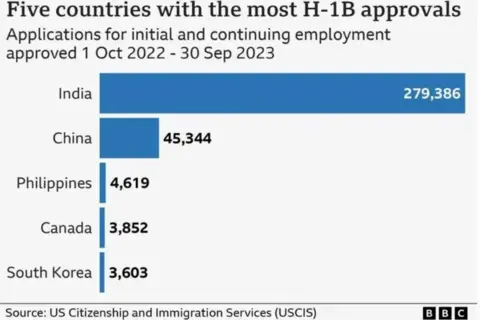
“Since the latest White House directive indicates that the fee would only apply to new H-1B recipients, this is more likely to cause medium and long-term labour shortages instead of immediate disruption,” Gil Guerra, an immigration policy analyst at the Niskanen Center, told the BBC.
India may feel the shock first, but the ripple effects could run deeper in the US. Indian outsourcing giants such as TCS and Infosys have long prepared for this by building local workforces and shifting delivery offshore.
The numbers tell the story: Indians still account for 70% of H-1B recipients, but only three of the top 10 H-1B employers had ties to India in 2023, down from six in 2016, according to Pew Research.
To be sure, India’s $283bn IT sector faces a reckoning with its reliance on shuttling skilled workers to the US, which accounts for over half its revenue.
IT industry body Nasscom believes the visa fee hike could “disrupt business continuity for certain onshore projects”. Clients are likely to push for repricing or delay projects until legal uncertainties are cleared, while companies may rethink staffing models – shifting work offshore, reducing onshore roles and becoming far more selective in sponsorship decisions.
Indian firms are also likely to pass on the increased visa costs to US clients, says Aditya Narayan Mishra of CIEL HR, a leading staffing firm.
“With employers reluctant to commit to the heavy cost of sponsorship, we could see greater reliance on remote contracting, offshore delivery and gig workers.”
The broader impact on the US could be severe: hospitals facing doctor shortages, universities struggling to attract STEM students, and start-ups without the lobbying muscle of Google or Amazon are likely to be hit hardest.
“It [visa fee hike] will force US companies to radically change their hiring policies and offshore a significant amount of their work. It will also ban founders and CEOs coming to manage US-based businesses. It will deal a devastating blow to US innovation and competitiveness,” David Bier, director of immigration studies at the Cato Institute, told BBC.

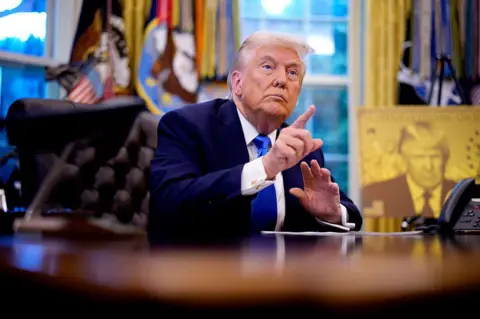 Getty Images
Getty ImagesThat anxiety is echoed by other experts. “The demand for new workers in fields like tech and medicine [in US] is projected to increase (albeit in uneven ways), and given how specialised and critical these fields are, a shortage that lasts even a few years could have a serious impact on the US economy and national well-being,” says Mr Guerra.
“It will likely also incentivise more skilled Indian workers to look at other countries for international study and have a cascading effect on the American university system as well.”
The impact, in fact, will be felt most sharply by Indian students, who make up one in four international students in the US.
Sudhanshu Kaushik, founder of the North American Association of Indian Students, which represents 25,000 members across 120 universities, says the timing – just after September enrolments – has left many new arrivals stunned.
“It felt like a direct attack, because the fees are already paid, so there’s a big sunk cost of anywhere between $50,000 and $100,000 per student – and the most lucrative route to entering the American workforce has now been obliterated,” Mr Kaushik told the BBC.
He predicts the ruling will hit US university intake next year, as most Indian students opt for countries where they can “put down permanent roots”.
For now, the full impact of the tax hike remains uncertain.
Immigration lawyers expect Trump’s move to face legal challenges soon. Mr Guerra warns that the fallout could be uneven: “I expect the new H-1B policy will bring a number of negative consequences for the US, though it will take some time to see what those may be.”
“For example, given that the executive order allows for certain companies to be excepted, it could be possible that some heavy H-1B users such as Amazon, Apple, Google, and Meta will find a way to be exempted from the H-1B fee policy. If they all get exemptions, however, this would largely defeat the purpose of the fee.”
As the dust settles, the H-1B shake-up looks less like a tax on foreign workers and more like a stress test for US companies – and the economy. H-1B visa holders and their families contribute roughly $86bn annually to the US economy, including $24bn in federal payroll taxes and $11bn in state and local taxes.
How companies respond will determine whether the US continues to lead in innovation and talent – or cedes ground to more welcoming economies.

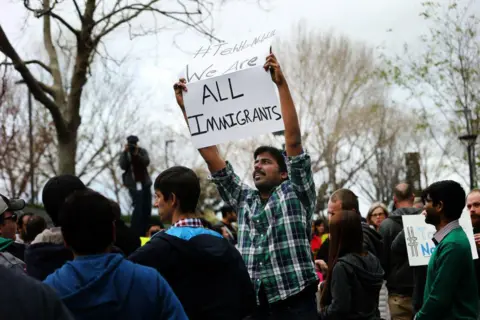 San Francisco Chronicle via Getty Images
San Francisco Chronicle via Getty ImagesWORLD
Apple Intensifies Clash with European Regulators: What You Need to Know!
Published
1 month agoon
September 22, 2025By
OBS
“Bureaucrats in Brussels” are unfairly challenging Apple’s closed ecosystem and denying users the “magical, innovative experience” that makes the firm unique, Apple said.
“We have a serious threat to that in Europe,” executive Greg Joswiak said in advance of the recent launch of its newest products and features.
The so-called walled garden that combines Apple’s products and software ensures a safe and high quality experience for users, it says, but EU regulators counter that it unfairly shuts out rivals.
The two sides have had years of rows, culminating in a €500m (£430m; $586m) fine handed down in April by the EU, which accuses the tech giant of anti-competitive behaviour on its App Store.
As part of the Digital Markets Act (DMA), which came into force in 2022 and began to apply in 2024, the EU targets several major tech companies.
In Apple’s case, the DMA requires it in part to ensure that devices, such as headphones, made by other brands will work with iPhones.
The DMA also requires that Apple allow notifications to show up on third-party smartwatches and not just the Apple Watch – and to let other platforms send and accept content to and from an Apple device via AirDrop.
“That’s a good thing for consumers, because that means that you actually have choice over which device you’re going to use, and you can get them to talk to one another, essentially,” said Sébastien Pant of BEUC, an umbrella group of dozens of consumer advocacy organisations.
“It’s important to try to tackle the kind of walled garden problem that we’ve had for years” and “try to provide consumers with more choice in the digital market,” Pant added.
But Apple is publicly pushing back as it releases its new AirPods Pro 3.
The wireless earphones will feature “Live Translation,” which allows users to hear in their preferred language on their AirPods.
The new AirPods Pro 3 and Live Translation were released last week in the US, but won’t be available to users in Europe for now, Apple said.
The company said the technology is currently only possible by having microphones on AirPods and the iPhone work together, and that opening up access to other devices would require extra engineering work in order to meet user expectations on privacy, security and integrity.
“They want to take the magic away – of having a tightly integrated experience that Apple provides – and make us like the other guys,” Joswiak said during a press briefing with reporters at its headquarters in Cupertino, California.
Apple has mostly refrained from airing its dirty laundry in public – at the request of the regulator, it said.
But it’s getting increasingly vocal as it argues that EU-style rules are bad for users and developers.
The European Commission, the EU’s executive body, on Friday published a decision rejecting Apple’s bid to have the body scrap most of its order requiring Apple to make its iPhone work with other devices.
Last month, the company issued a statement warning the UK’s competition watchdog against following the EU’s lead as the Competition and Markets Authority (CMA) moves ahead with plans aimed at opening up markets dominated by Apple and Google.
European regulators are “creating a worse experience for their citizens – our users,” Joswiak said. “They’re undermining innovation, they’re infringing our intellectual property and they’re damaging privacy and security.”
The BBC reached out to the European Commission for a response.
Apple previously delayed the rollout of its AI-focussed Apple Intelligence features in the EU.
Other companies have also withheld features in the EU because of the DMA, Pant said.
That includes Instagram and WhatsApp’s parent company Meta, which delayed rolling out its social media app Threads in the EU for several months to comply with EU regulations concerning tech firms’ gathering of user data.
WORLD
Outdoor Brand Issues Apology After ‘Dragon’ Fireworks Cause Controversy in the Himalayas – Find Out Why!
Published
1 month agoon
September 22, 2025By
OBS
Osmond ChiaBusiness reporter

 Via Global Times
Via Global TimesChinese officials are investigating outdoor clothing brand Arc’teryx after it apologised for a fireworks display in the Himalayan region of Tibet, which drew backlash for its potential impact on the fragile ecosystem.
Videos from the 19 September event show multi-coloured fireworks erupting across foothills in a display intended to resemble a dragon, designed by Chinese artist Cai Guo-Qiang.
But the promotional campaign sparked a barrage of criticism online, with people saying the stunt contradicts Arc’teryx’s image as a conservation-focused brand and calling for a boycott of its clothing line.
The Canadian firm apologised for the display, saying it was “out of line with Arc’teryx’s values”.

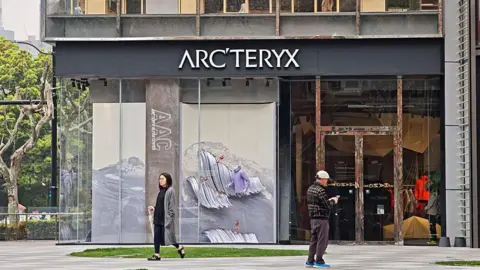 Getty Images
Getty ImagesThe firm said that it will work with an external agency to assess the project’s impact, adding that it had used entirely biodegradable materials. Arc’teryx also said that the spectacle was aimed at raising awareness of mountain culture.
Founded in 1989, Arc’teryx is hugely popular for its high-end sportswear and mountaineering gear and runs more than 150 shops globally. It is owned by Hong Kong-listed fitness equipment company Anta Sports.
It partnered with pyrotechnics artist Cai to stage the high-altitude day-time display called Rising Dragon, set at over 5,000 meters in Tibet’s Shigatse region, a gateway to Himalayan peaks like Everest.
The mountains are also sacred to people in Tibet, where many follow Buddhism. It has been a tightly-controlled part of China since it was annexed in the 1950s, leading some online to ask how and why the project was approved in the first place.
Critics said the mountains were too fragile for fireworks, and the explosions, colour and smoke would have disrupted the ecosystem and local wildlife.

 Getty Images
Getty ImagesA top comment on Arc’teryx’s apology post said the display was “not something that can be forgiven with a single apology post”, and urged the company to take responsibility for any long-term environmental impact.
Another commenter questioned how a project of such scale could have been approved by so many people.
“The public’s criticism has alerted us that the evaluation of the expression of art needs to be more professional and we need to be more humble and respectful of nature,” Arc’teryx said in its statement.
Mr Cai, the artist who has also been criticised, has apologised for his role and said he would work with authorities to help in the area’s recovery.
The 67-year-old artist made his name with gunpowder paintings and outdoor pyrotechnic displays. He famously oversaw fireworks for the 2008 Beijing Olympics.
Categories
Top Tags
Related posts






















